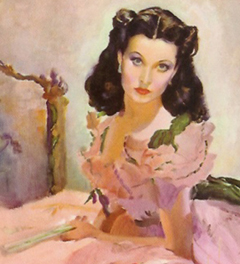
Vivien Leigh as Scarlett O’Hara
May 19 will mark the 75th anniversary of the publication of Gone With the Wind, Margaret Mitchell’s classic tale of the Civil War South. Two months after the novel appeared, David O. Selznick bought the film rights, and production of the blockbuster movie began in January 1939.
On the day scheduled to film the “burning of Atlanta” scene, Oscar Payne Cleaver, a native of Hart County, Kentucky, arrived on the set. His innovative work as an electrical engineer at Westinghouse had attracted the attention of Selznick, who hired him as a lighting consultant. Cleaver’s experiences left him with vivid impressions and memories. Vivien Leigh (“Scarlett O’Hara”) was sweet and friendly and played croquet with him, while Clark Gable (“Rhett Butler”) was stand-offish and kept blowing his lines. Hattie McDaniel (“Mammy”) was well-spoken, without a trace of her character’s thick dialect. Leslie Howard (“Ashley Wilkes”) struggled to subordinate his English accent to that of a Southern gentleman. Not only did Cleaver witness many fascinating tricks of cinema production, he came away with a story about the genesis of Rhett’s immortal (and controversial) parting words to Scarlett. “Frankly, my dear, I don’t give a damn,” Cleaver claimed, was less a carefully scripted dramatic moment than a byproduct of Gable’s frustration with his mangled lines.
Oscar Cleaver’s memories of his experiences on the set of Gone With the Wind are part of the collections of WKU’s Special Collections Library. Click here to download a finding aid. Also in our collection is an attractive souvenir booklet sold at theatres showing the film — download the finding aid here. Packed with images, cast and crew lists, and production facts (59 cast members, 2,400 extras, 1,100 horses, 5,500 items of wardrobe design, 90 screen tests of potential “Scarletts”), the booklet attests to the challenge of adapting a thousand-page novel that sold more than 50,000 copies on its first day of issue, 75 years ago this month.
